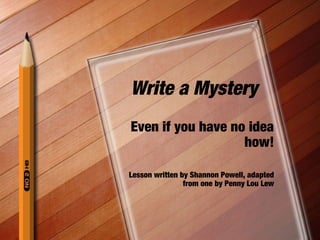
Mystery Writing Lesson
- 1. Write a Mystery Even if you have no idea how! Lesson written by Shannon Powell, adapted from one by Penny Lou Lew
- 2. 1. You are finally out of school after a long, busy week. You are just about to do your favorite activity. Describe how you get home from school, how you feel, what the activity is, what you’re doing, and what is going through your mind at the time.
- 3. 2. Your (or someone’s) cell phone rings, but you don’t answer it for some reason (can’t? won’t? didn’t hear it?). Describe what goes through your mind during the ringing, and what you do or don’t do, but don’t answer it and don’t shut it off completely.
- 4. 3. After a few quiet moments, the phone rings again, and this time you do answer it. On the other end is someone who needs your help (do you know this person?). They have discovered a mystery to solve, and are frantically trying to explain it to you. Explain who the person is and use dialogue to describe your conversation. (By the end of this slide you should know what question the reader will
- 5. 4. You decide you must help. Arrange with the person on the phone to meet somewhere (tell us where) and head there. Use dialogue to end the conversation, and action sentences to explain your leaving. (How do you get to the place?) **If you have set it up so that you cannot meet this person, just decide to GO somewhere.
- 6. 5. Describe the setting as you arrive to meet the other person. Someone (maybe the person on the phone or maybe someone else - a victim, a witness, a suspect, etc.) comes up to you. Describe this person and give the audience hints at his/her personality. (Don’t talk yet.)
- 7. 6. What do you and this other person talk about? Use dialogue to explain the conversation. Remember to use body language and facial expressions to help the reader “see” what is happening.
- 8. 7. As the person you’re talking to walks away (give your audience a reason), you set to work examining the scene. What does it look like? What are some of the interesting things that you notice? Use plenty of detail and as many of the five senses as you can to explain your surroundings.
- 9. 8. While you are examining the scene, you come up with a couple of questions that should help you solve the case. What are the questions? (Think about what clues you will need to solve the mystery.) Have your character decide who to question to solve the case.
- 10. 9. How do you find/get your suspects to question them? Who are they? List the three witnesses/suspects and their responses to your two questions. (For this rough draft, you could even make a list or a chart to complete later.)
- 11. 10. During the interrogation, you notice something extremely suspicious, either on one of the suspects, near him/her, or in something he/she said. What is it? (Think about that key clue to solve your mystery or catching someone in a lie.)
- 12. 11. As the interrogation draws to a close, you notice another clue, either something in what someone says or an actual physical object. What is it, and what does it make you think or do? (Use dialogue, thoughts, and action sentences.)
- 13. 12. Now you are alone, giving you an opportunity to more closely examine the evidence you discovered. It clearly points to one of the suspects. What information does it give you, and what do you decide to do about it? (Describe your thoughts and actions.)
- 14. 13. You decide to confront the suspect, but when you get to the person, he/she is about to escape or is already gone. You act quickly. Describe what happens. Use plenty of action and description, and dialogue if necessary.
- 15. 14. After a struggle, the suspect confesses. He/she confirms what you thought, and even gives a motive for the crime. Explain in detail how this scene plays out. Use dialogue, thoughts, and actions. Don’t forget body language, especially for the suspect.
- 16. 15. Somehow, conclude this story. 16. Or, if you prefer, go back to around where slides 11 and 12 are, and try to end the story with a “Who did it?” -type ending like the short stories we read earlier. Make sure that essential clue is in the story somewhere. 17. *Bonus for having a red herring!